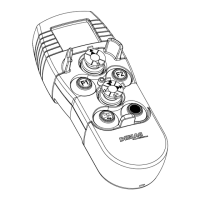16
211 338 44.indd / 081019
The charging process is monitored and controlled by the electronics in the
DRC-MJ D3 hand-held transmitter. Partly discharged batteries can also be
charged.
To charge the batteries, proceed as follows:
– Plug the charger unit into a power socket.
– Plug the connecting cable into the charger socket of the DRC-MJ D3 hand-held
transmitter.
The
icon will appear on the screen.
The red LED fl ashes at 2 Hz.
The DRC-MJ D3 hand-held transmitter generates an acoustic signal.
The hand-held transmitter will be charged.
The DRC-MJ D3 hand-held transmitter changes to standby mode. The crane
cannot be operated.
The charging process comprises quick charging and trickle charging modes.
Quick charging: This process takes approx. 2 hours if the battery is empty, it
charges the battery to a charge level of approx. 100%.
Trickle charging: At the end of the quick-charging phase, the system switches
over to trickle charging mode with a lower charging current
so that the DRC-MJ D3 hand-held transmitter can remain
connected to the charger for any period of time. This also
indicated by an acoustic signal.
Icon when the charging process has been completed. The
red LED goes out.
Icon to show there is no battery fitted.
Icon for battery errors.
This icon appears if a battery problem occurs, e.g.:
• batteries are defective,
• batteries are too old,
• attempt to charge non-rechargeable batteries.
Defective batteries must be replaced by new ones (see section 6.3.3)
43649444_xml.eps
A
C
DB
E
G
F
Important
To ensure sufficient charging of empty batteries, the DRC-MJ D3 hand-held
transmitter must be connected to the charger for at least 2 hours. The full
battery icon is not sufficient after the charger plug is disconnected, as this icon
already appears after a only brief period of charging.
i

